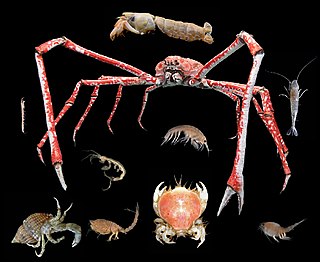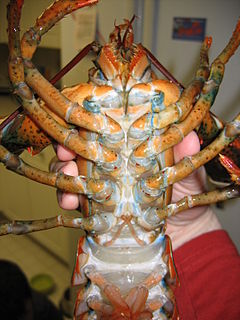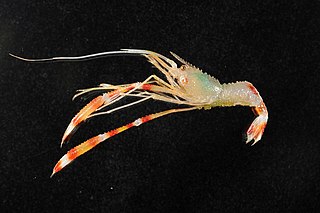
The Caridea, commonly known as caridean shrimp or true shrimp, are an infraorder of shrimp within the order Decapoda. This infraorder contains all species of true shrimp. They are found widely around the world in both fresh and salt water. Many other animals with similar names – such as the mud shrimp of Axiidea and the boxer shrimp of Stenopodidea – are not true shrimp, but many have evolved features similar to true shrimp.

Malacostraca is the largest of the six classes of crustaceans, containing about 40,000 living species, divided among 16 orders. Its members, the malacostracans, display a great diversity of body forms and include crabs, lobsters, crayfish, shrimp, krill, prawns, woodlice, amphipods, mantis shrimp and many other, less familiar animals. They are abundant in all marine environments and have colonised freshwater and terrestrial habitats. They are segmented animals, united by a common body plan comprising 20 body segments, and divided into a head, thorax, and abdomen.

Anomura is a group of decapod crustaceans, including hermit crabs and others. Although the names of many anomurans include the word crab, all true crabs are in the sister group to the Anomura, the Brachyura.

Stenopus hispidus is a shrimp-like decapod crustacean belonging to the infraorder Stenopodidea. Common names include coral banded shrimp and banded cleaner shrimp.

A gonopore, sometimes called a gonadopore, is a genital pore in many invertebrates. Hexapods, including insects have a single common gonopore, except mayflies, which have a pair of gonopores. More specifically, in the unmodified female it is the opening of the common oviduct, and in the male, it is the opening of the ejaculatory duct.

The family Polychelidae contains thirty-eight extant species of blind, benthic lobster-like crustaceans. They are found throughout the world's tropical, sub-tropical and temperate oceans, including the Mediterranean Sea and the Irish Sea.

Hippolytidae is a family of cleaner shrimp, also known as broken-back shrimp or anemone shrimp. The term "broken-back shrimp" also applies to the genus Hippolyte in particular and "cleaner shrimp" is sometimes applied exclusively to Lysmata amboinensis.

Alpheus novaezealandiae is a species of shrimp in the family Alpheidae, found in Australasia.
Hippolyte bifidirostris is a chameleon shrimp of the family Hippolytidae, found around New Zealand at depths of 18–36 metres (59–118 ft). It may also occur on Australia's Great Barrier Reef, but that record may need to be confirmed.

Dardanus pedunculatus, the anemone hermit crab, is a species of hermit crab from the Indo-Pacific region. It lives at depths of up to 27 m and collects sea anemones to place on its shell for defence.

Amarinus lacustris is a species of freshwater crab from Australia, New Zealand and nearby islands, where it lives in water of various salinities. It grows up to 10 mm (0.4 in) wide, with an H-shaped groove on its back. It is an omnivore and is eaten by crayfish and fish. It was first discovered in Lake Pupuke, near Auckland, and is the only freshwater crab in New Zealand.

Pagurus sinuatus is a large species of hermit crab found in Australia and the Kermadec Islands. It is red or orange in colour with coloured bands on the legs and patches on the body.

Nematocarcinoidea is a superfamily of shrimp, comprising four families – Eugonatonotidae, Nematocarcinidae, Rhynchocinetidae and Xiphocarididae. They share the presence of strap-like epipods on at least the first three pairs of pereiopods, and a blunt molar process.

Hypothalassia is a genus of temperate and tropical deep sea crabs that are found in both Australian and Japanese waters. It comprises two species: Hypothalassia acerba Koh & Ng, 2000, and Hypothalassia armata, both known as the champagne crab.
Dorphinaxius kermadecensis is a genus of mud lobster native to the Norfolk Island, parts of New South Wales, and the Kermadec Islands of New Zealand. It is the only species in the genus Dorphinaxius. It has a depth range of 0–8 metres (0–26 ft).

Shrimp are decapod crustaceans with elongated bodies and a primarily swimming mode of locomotion – most commonly Caridea and Dendrobranchiata. More narrow definitions may be restricted to Caridea, to smaller species of either group or to only the marine species. Under a broader definition, shrimp may be synonymous with prawn, covering stalk-eyed swimming crustaceans with long, narrow muscular tails (abdomens), long whiskers (antennae), and slender legs. Any small crustacean which resembles a shrimp tends to be called one. They swim forward by paddling with swimmerets on the underside of their abdomens, although their escape response is typically repeated flicks with the tail driving them backwards very quickly. Crabs and lobsters have strong walking legs, whereas shrimp have thin, fragile legs which they use primarily for perching.

Prawn is a common name for small aquatic crustaceans with an exoskeleton and ten legs, some of which can be eaten.

Stenopus scutellatus, commonly known as the gold coral banded shrimp or golden coral shrimp, is a boxer shrimp, a shrimp-like decapod crustacean belonging to the family Stenopodidae. It is found in suitable habitats in the western Atlantic and the Caribbean Sea.

Thoridae is a family of cleaner shrimp, also known as broken-back shrimp or anemone shrimp.

Stenopus pyrsonotus is a shrimp-like decapod crustacean belonging to the infraorder Stenopodidea, native to the Indo-West Pacific region. Common names include flameback coral shrimp, ghost boxing shrimp and cave shrimp; the species is sometimes kept in reef aquariums.


















